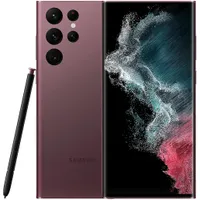TechRadar Verdict
Gaming phones are always powerful, but they're seldom polished. The ROG Phone 6 is both, matching best-in-class performance with effective cooling and a rich selection of accessories. While we wish Asus went a bit further with the camera and wireless charging, there are enough standout and unique highlights here to make it the best gaming phone available at launch.
Pros
- +
Excellent battery life
- +
Great selection of accessories
- +
Powerful and stays cool
- +
Bold, bright, smooth screen
Cons
- -
No wireless charging
- -
Weak camera mix for the price
- -
Pricier than competition
Why you can trust TechRadar
Two-minute review
Do you even need a gaming phone when handsets like the iPhone 13 Pro Max or Samsung Galaxy S22 Ultra are such capable pocket powerhouses? Asus thinks so, and the ROG Phone 6 is its latest attempt at giving you a smartphone by daylight, and handheld console by neon lights of your RGB-lit den.
If you're not a gamer, then the ROG Phone 6 isn't for you. It's that simple. Starting with its design, this phone looks like it could transform into a tiny robot and take over the world; you'll probably either love it or hate it. We love it.
Both the ROG Phone 6 and 6 Pro get a color screen around the back, a feature that was previously reserved for the Pro version. Also new, the ROG Phone 6 is available in both black and white – the latter looking particularly sleek when matched with the new selection of off-white accessories.
Given that the phone also sounds good and lasts a full day without a midday charge – thanks to its huge 6000mAh battery – it's safe to say our general impression of the ROG Phone 6 has been an excellent one. That said, it isn't perfect.
While gaming phone cameras are usually mediocre to bad, the ROG Phone 6's is just good enough. This phone is pricey, so it's natural for us to expect a little more – possibly OIS on the main lens, a bit of telephoto reach or a wide/macro camera with autofocus.
The phone also misses out on wireless charging, which is becoming more ubiquitous, and is something of a must in the ROG Phone 6's price bracket.
Despite those quibbles, the ROG Phone 6 is still the very best gaming phone you can buy. While it costs more than the Poco F4 GT, it's more powerful and features a richer accessory suite. The Red Magic 7 and 7 Pro are also cheaper alternatives but lack the polish Asus brings to the table.
Sign up for breaking news, reviews, opinion, top tech deals, and more.
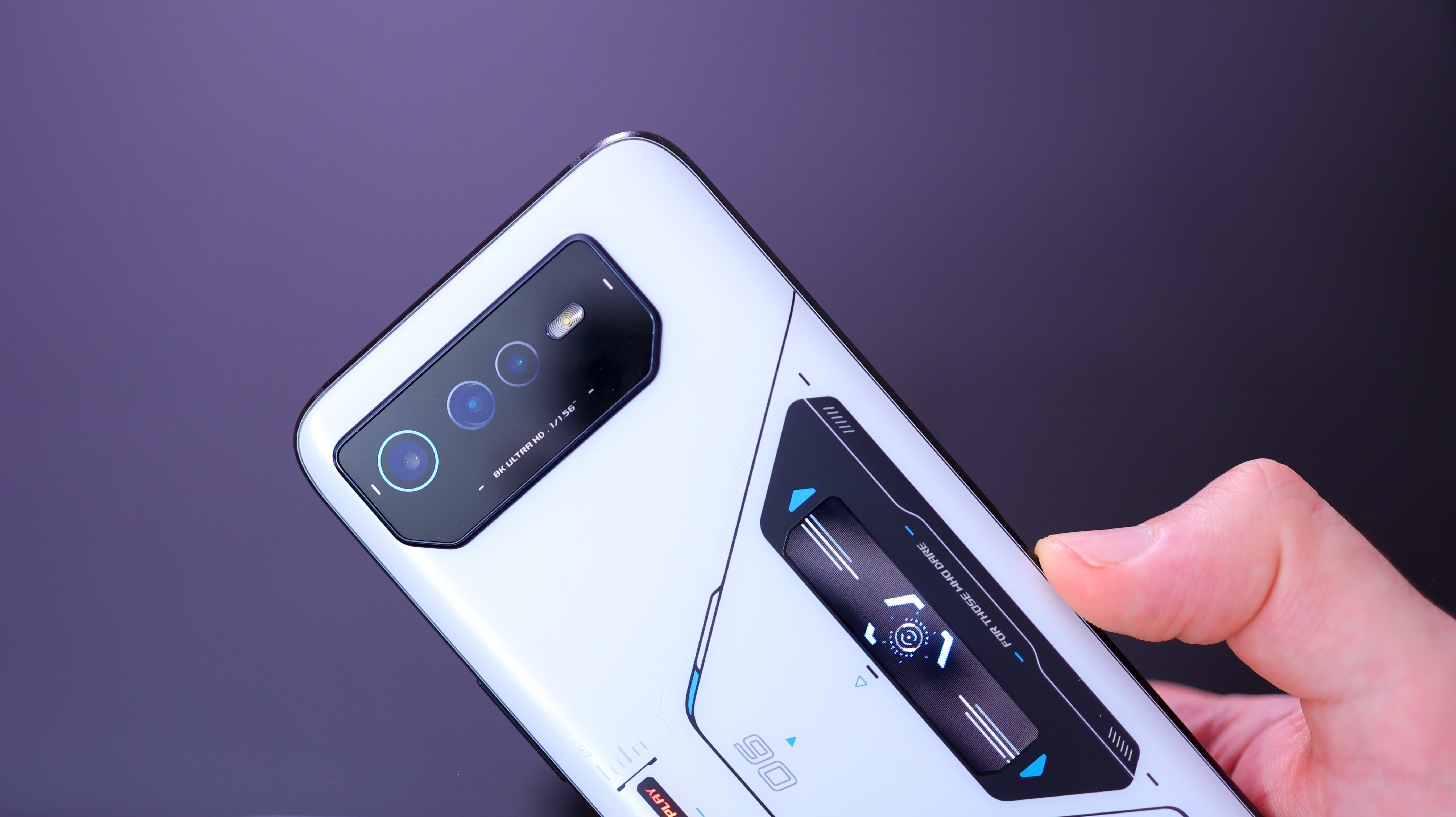
Asus ROG Phone 6: price and availability
- Starts at £899 (US price TBC)
- Available in three versions
- Regional availability TBC
The Asus ROG Phone price ranges from high to eye-watering, starting at £899 for the standard version with 256GB storage and 12GB RAM. Alternatively, for £999, you can pick up the phone with 512GB storage and 16GB RAM. If you want to spend even more, the Pro version, which also has 512GB storage, but takes the RAM up to 18GB, – and adds an LED light on the back – costs £1,199. US pricing will be confirmed imminently, so we'll update this as soon as Asus announces it.

This is the same pricing structure we've seen from Asus's ROG Phone line before – charging more than much of the gaming phone competition but delivering a superior user experience. The Red Magic 7 starts at £529, in contrast, and is a great option for anyone who doesn't mind a few rough edges. That said, Asus offers more storage at the ROG Phone 6's starting capacity and a much more refined software experience.
We know the phone's coming to the UK and will be available from Asus's online store. Other regions and retailers are yet to be confirmed.
- Value score: 4/5
Asus ROG Phone 6: design
- Striking gaming phone look
- Available in two styles
- Excellent accessory support
As far as gaming phones go, the ROG Phone 6 is one of the more elegant options around with its curved, smooth, pearlesque, frosted glass back, and its rounded metal sides. If you close your eyes while holding it, despite being big, it's still a comfortable, premium smartphone – nothing too standout. Open your eyes though, and you'll be sucked into a world of RGB lighting, second-screen action, and Stargate-style glyphs.
Measuring 173 x 77 x 10.3mm, the ROG Phone 6 is a tall, relatively narrow thing that's thicker than most smartphones, but doesn't quite feel unwieldy. At 239g, it's one of the heaviest phones on the scene, with the iPhone 13 Pro Max weighing just one gram more at 240g.
The curvy, frosty back and matte sides do make the ROG Phone 6 feel rich and alluring, but it is pretty slippery, so you'll want to put a case on as soon as you start using it. Luckily, in the box, you get a lightweight, hard plastic shell that protects the corners and adds a little extra grip.
The ROG Phone's screen is protected by Gorilla Glass Victus, and while the phone doesn't sport IP68 water or dust resistance, it's the first gaming phone with IPX4 splash-resistant certification. As for color options, the standard ROG Phone 6 is available in Phantom Black and Storm White, while the 6 Pro is available exclusively in Storm White.

Dotted around the curved metal frame of the ROG Phone 6 are more ports than we're used to seeing. In addition to the 3.5mm headphone jack – a unicorn by today's high-end smartphone standards – there's a second USB port on the side of the phone. This is for accessories, like the dock and fan, but also makes for a comfortable charging option when gaming in landscape orientation.
Asus doesn't install a pre-fitted screen protector on the phone, but does offer up an official option as a separate purchase. We had no issues with the in-display fingerprint scanner, and also set the phone's face unlock up to ensure we could get into it quickly.



The most standout design highlight of the ROG Phone 6 is definitely on the back. Sprinkled among a bunch of etchings and visual flourishes – as well as a confident, angular camera bump – is an OLED screen. This is horizontal on the Pro model, pictured above, and pitched at an angle on the standard ROG Phone 6.
More than just a flashy highlight for gamers, Asus adds some utility to the second screen. It can display your notification icons, and battery capacity while charging. Really though, who are we kidding? This thing is totally unnecessary – pure indulgence and we're more than okay with that.
- Design score: 4.5/5
Asus ROG Phone 6: display
- Custom Samsung AMOLED display tech
- Tall and smooth with a 165Hz refresh rate
- Wide, Full HD resolution
For the most part, the ROG Phone 6 has the same display as its predecessor. That means it’s a 6.78-inch Samsung AMOLED display with a 2448 x 1080 resolution. It's improved in one key area though: refresh rate. While the ROG Phone 5 had a 144Hz refresh rate, the ROG Phone 6 climbs up to 165, bringing it in line with the best gaming phones around.
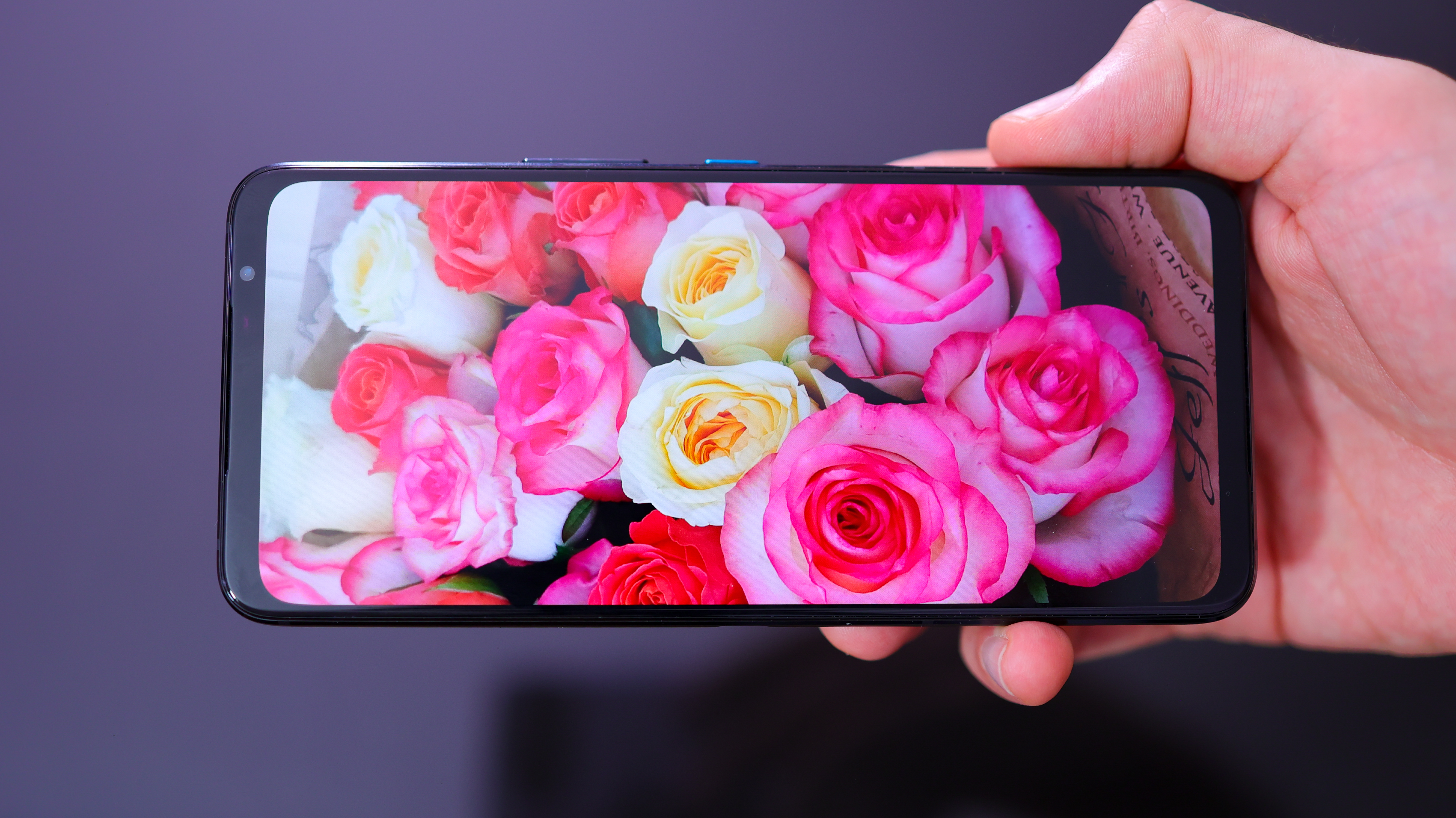
The ROG Phone 6's humble 2448 x 1080 resolution is low for a smartphone that costs as much as it does, but it's on the money for a gaming phone. Most games are displayed in Full HD, and the lower resolution keeps frame rates nice and high. In turn, what you may lose in clarity, you make up for in motion smoothness, whether gaming, swiping through websites, or scrolling through social feeds.
Samsung and Asus have teamed up once again to create an excellent screen-quality experience on the ROG Phone 6. Colors are vibrant, perfect for gaming and watching movies on; and manual brightness is great indoors, going super-dark and climbing up to 800 nits. In direct sunlight, you'll definitely want to activate high-brightness mode by turning on auto-brightness. Otherwise, you might struggle to see very much.
Asus loads up the display settings with plenty of viewing modes, including Natural. Cinematic and Standard,– and you can also customize a personal color profile to suit your eyes.
- Display score: 4.5/5
Asus ROG Phone 6: cameras
- 50MP primary camera with IMX766 sensor
- Up to 8K 30fps and 4K 120fps video recording
- Mediocre secondary camera mix
We always curb our expectations when testing out gaming phone cameras, but were delighted to discover the ROG Phone 6 features the same 50MP camera sensor as the Oppo Find X5 Pro: a Sony IMX 766. We've seen this on a few phones – though it's always been matched with a lens featuring optical image stabilization (OIS). On the ROG Phone, however, none of the lenses are optically stabilized.
The phone packs three cameras around the back in total: the main 50MP, f/1.9 camera, an ultra-wide 13MP, f/2.2 camera, and a 5MP f/2 macro camera. Only the main camera packs autofocus, with the ultra-wide focusing at around a meter, and the macro camera focusing at 4cm.

Out of the gate, we were able to grab some decent photos with the ROG Phone 6. Asus's processing is a bit heavy-handed, so photos are crammed with contrast – but that's not necessarily a bad thing. Many will like the very shareable veneer of ROG Phone's photos, especially those shot in well-lit scenes. The shift from a 64MP Samsung sensor to a lower-resolution – but larger – 50MP Sony sensor has definitely paid off for Asus.
The phone's night mode is also impressive at grabbing a bit of extra detail with a long exposure. The best thing about it is that it kicks in automatically when the lights drop, so you don't need to activate it, whether shooting on the primary or ultra-wide cameras.
The worst photos we took on the ROG Phone 6 were those taken with a shaky hand or in semi-well-lit environments, that cusp between activating night mode and utilizing the short shutter speed with just enough light. This is where OIS would have really helped things along.
The ultra-wide camera shares a similar weakness, but it's a bit more pronounced when night mode isn't fired up. As for the macro camera, this is the weakest camera of the three. Most of the time, we were able to get better macro results by shooting with the main camera and cropping in.



The ROG Phone 6's selfie camera and video capture are among the most impressive aspects of the camera mix. While detail from the front camera isn't standout, it does a good job of capturing natural, flattering photos. Meanwhile, video is captured at up to 8K resolution at 30fps, or 4K resolution at up to 120fps.
Video is well stabilized at up to 8K 30fps or 4K 60fps, and looks great in bright environments. Focus is swift too, and enthusiasts can fire up Pro video for more granular control over camera settings. A couple of features missing from the ROG Phone that we're seeing on more camera phones are LOG mode and 21:9 capture. Maybe next time, Asus?
- Camera score: 3.5/5
Camera samples






Asus ROG Phone 6: performance and specs
- Powerful Snapdragon 8+ Gen 1 chipset
- 256GB or 512GB storage
- Stays cooler than much of the competition
The Asus ROG Phone 6 introduces Qualcomm's Snapdragon 8+ Gen 1, a higher-clocked version of the 8 Gen 1 found in flagships like the Sony Xperia 1 IV and Xiaomi 12 Pro.
While the original 8 Gen 1 has become known for getting hot under pressure, Asus has done a lot to help the ROG Phone 6 keep its cool, despite its mightier iteration of Qualcomm's processor.
Asus has repositioned the processor (the heat source) to the middle of the phone. This does a few neat things: it moves the heat further away from your hands, especially when playing in landscape orientation. It also moves it further from the metal frame (a heat conductor) and positions it exactly under the optional fan accessory. We were dubious at first, given the fact that it has no ventilation channels, but have been impressed with the ROG Phone 6's heat management during our time with it.

Hours of playing emulators and low-stress games like Streets of Rage and Final Fantasy IX didn't heat the phone up at all, and it took about half an hour playing Genshin Impact on maxed-out graphics settings before we really started to notice things get close to hot at those points where our hands held the phone.
What heated the phone up more than gaming was 5G downloads, with a 13GB download heating the ROG Phone up to about 42º C; 20 minutes of gaming only heated it to 40º C.
About 10 minutes with the AeroActive Cooling Fan dropped the temperature by 3ºC, and if we started playing with it plugged in, the phone stayed relatively cool – so we used it specifically for graphically intensive titles.
It isn't just heat that's managed well by the ROG Phone. We were able to stream games super-smoothly using Asus's WiFi and cellular aggregating feature. Where we live, our 5G speeds actually outperform our WiFi speeds, so using both meant we got excellent results while streaming Ghost Runner through Nvidia's GeForce Now, or playing back Dragon Ball Fighter Z on Xbox Game Pass.
- Performance score: 5/5
Asus ROG Phone 6: software
- Runs Android 12 with Asus's Zen UI
- Optional non-gaming UI available
- Game Genie software great for gaming
Asus's ROG Phone 6 runs with Android 12, and games and apps are widely available through the Google Play Store. Out of the box, while you shouldn't expect any pre-loaded games, you should expect big-gamer energy. The whole interface is gaming-themed, and when you squeeze the sides of the phone, its performance mode, called X-Mode, activates, complete with a wallpaper change.
While we're normally in favor of more stock interfaces, the spirit of gaming gear is often celebrating excess – maximalism for the win. With that attitude, the ROG Phone's UI shines, loaded up with motion wallpapers and lock screens. That being said, if you want to dial things back, you can activate a much more stock mode. This gives you access to all the apps and features you'll need from your gaming phone, but with a much more conservative look and feel.
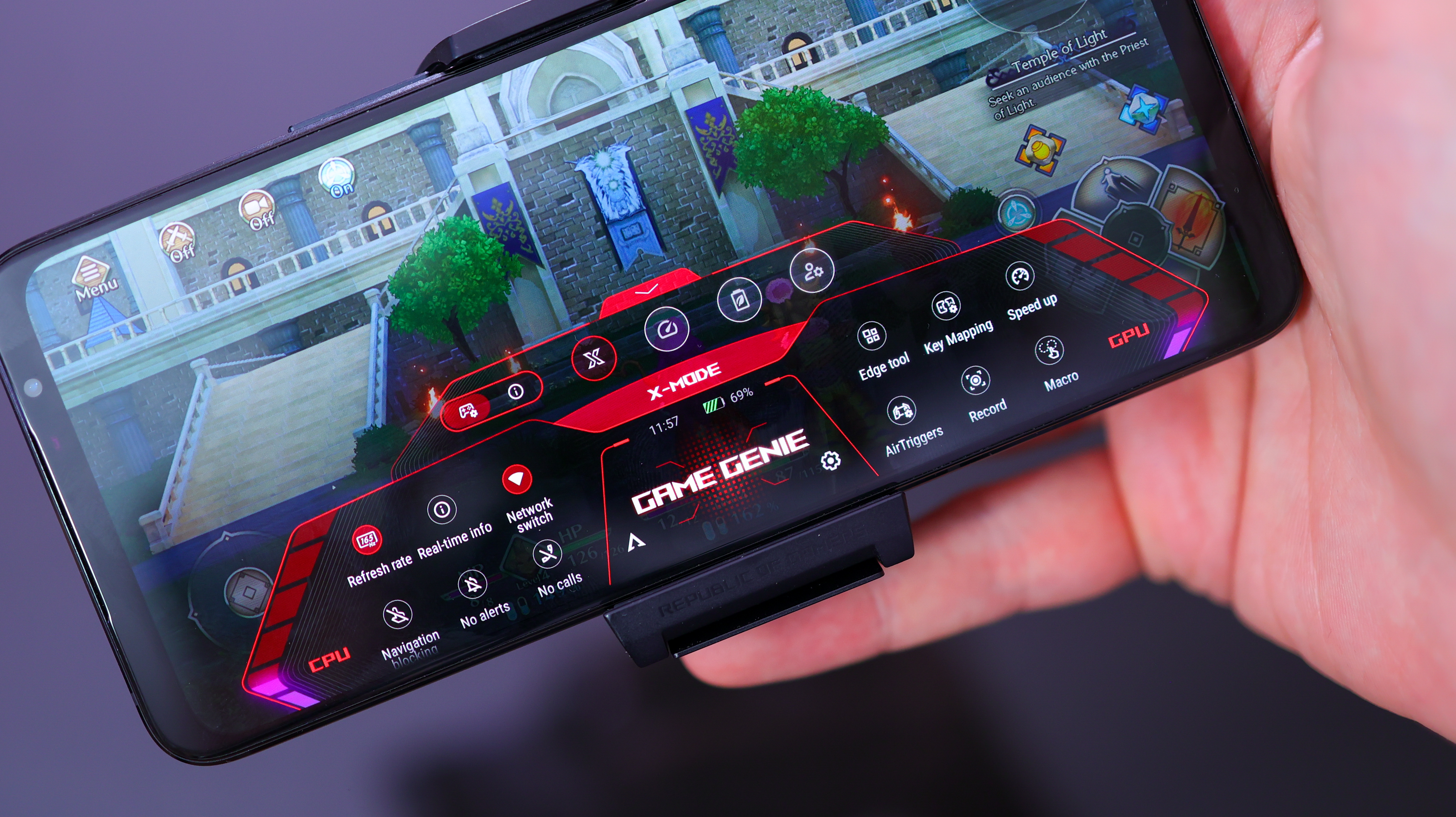
However, the best software enhancements on the ROG Phone 6 come in the form of Armory Crate and Game Genie. The first, Armory Crate, is where you can find your games, control your official accessories, find new high-refresh-rate titles, access the ROG community and your own profile.
Game Genie is Asus's in-game software. There's virtually no end to what you can do with it – but the crux of the functionality comes down to creating game-specific profiles, be they mapped keys, macros, or setting crosshairs – and that's just scratching the surface.
We used Game Genie to map keys for our various controllers, converting non-controller optimized games, and playing them back on our TV, plugged in via an HDMI adapter.
While non-gamers and folks who don't want a gaming phone might find the whole ROG Phone experience overkill, the fact it can all be dialed up or down means if you're prepared to invest in making the phone your own, the payoff will be sweet.
- Software score: 4.5/5
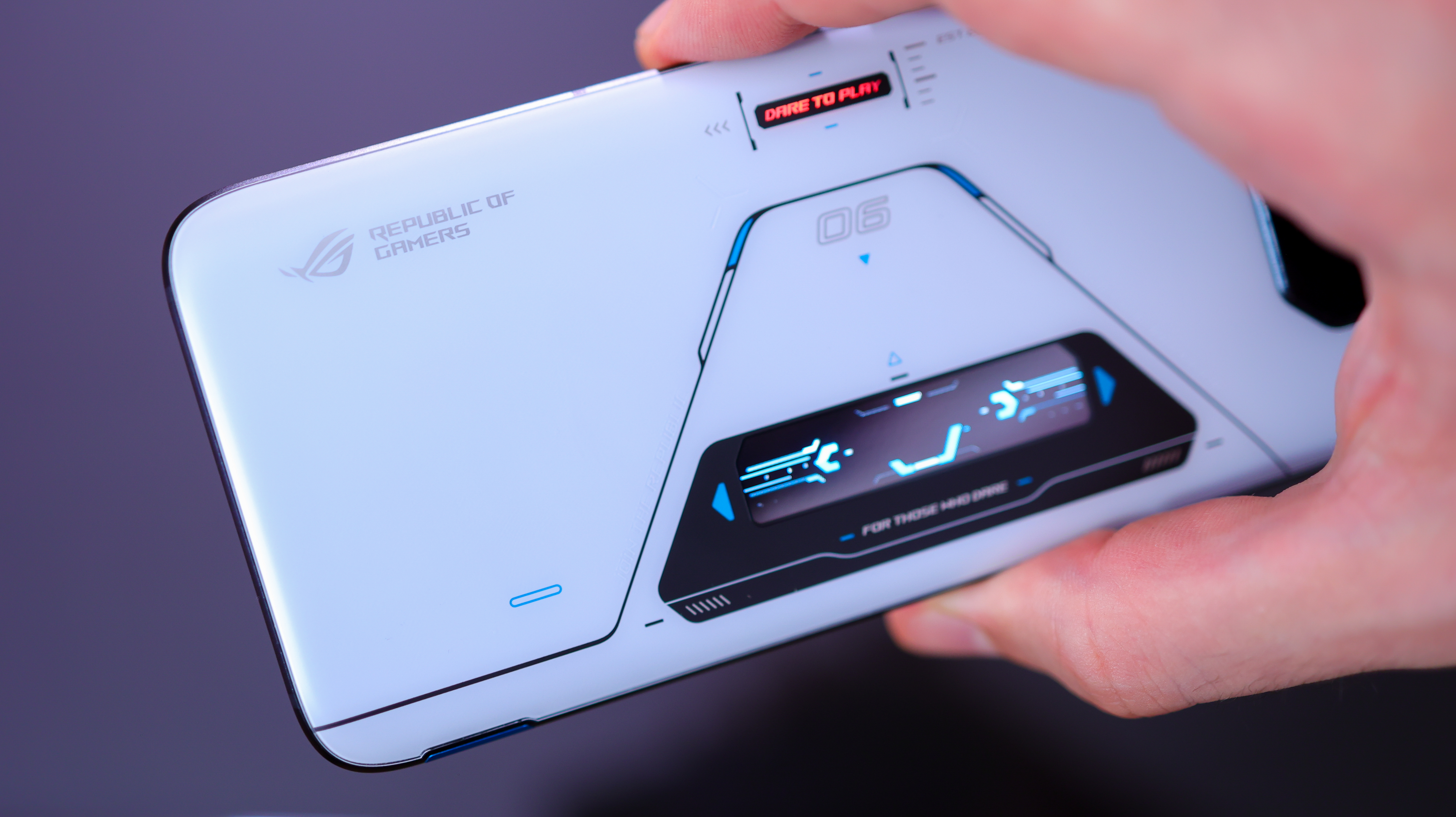
Asus ROG Phone 6: battery life
- High-capacity 6,000mAh battery
- Fast 65W charging
- Accessories drain battery fast
Another year, another 6,000mAh ROG Phone, and we couldn't be happier Asus didn't shave down the capacity. Unsurprisingly, the phone lasts a very long time, dropping 80 percent in around 16 hours with the screen on, doing automated tasks like web browsing and basic photo and video editing.
Plug in some accessories and this number goes way down. With the fan fired up and the Kunai Gamepad physically plugged into the phone, expect a few hours of gameplay at most.
Knowing you'll likely want to charge your ROG Phone 6 while playing games, Asus made an optional, bypass-charging mode available. This provides power to the system from the charger without actually powering up your battery, thereby reducing battery wear and managing heat just a bit better.
With 65W fast, wired charging, the ROG Phone 6 powers up in under 45 minutes – a perfectly respectable, though not class-leading, charging speed. The phone also ships with a charger in the box – bad for the planet, potentially good for your wallet. We've yet to see any gaming phone brands take Apple, Samsung, and Sony's route, zapping charging components from their smartphone boxes.
Something else gaming phones don't tend to feature is wireless charging, so its absence on the ROG Phone 6 is no surprise. That said, with the feature becoming more widespread, with any luck, that will change soon.
- Battery score: 5/5
Asus ROG Phone 6 scorecard
| Attributes | Notes | Rating |
|---|---|---|
| Design | Love it or hate it, the premium finish and gaming phone highlights make the ROG Phone 6 a standout in its category. | 4.5/5 |
| Display | While the ROG Phone 6's screen isn't the sharpest around, it's exactly where it needs to be for a gaming phone, and the image quality and brightness are on point. | 4.5/5 |
| Performance | Asus is the first to market with Qualcomm's latest processor, which, matched with effective cooling ensures performance, whether gaming or simply using your phone is excellent. | 5/5 |
| Camera | The ROG Phone's weakest area is its camera, despite improvements over its predecessor. Nevertheless, the main camera still impresses with good looking photos and videos. | 3.5/5 |
| Battery | With a bigger battery than the most smartphones and fast charging, it's little wonder the ROG Phone 6's battery impressed us. The only thing missing is wireless charging. | 5/5 |
| Software | Asus has finetuned its gaming software to near-perfection over the years, and the latest iteration is stellar. We also like the dialled back theme that feels more stock. | 4.5/5 |
| Value | While you can get a better camera phone for less, the ROG Phone 5 is the best gaming phone around, and that helps justify its confident, but not unreasonable price. | 4/5 |
Should I buy the Asus ROG Phone 6?

Buy it if...
You want a powerful gaming phone
The ROG Phone 6 is an incredibly powerful gaming phone that can handle even the more power-hungry games without getting too hot under the collar.
You love gaming accessories
Whether you want to clip the ROG Phone to your Xbox controller, use it like a Nintendo Switch with the Kunai Gamepad, or keep it cool with a fan – you can Megazord your ROG Phone 6 with a whole bunch of great-looking, RGB-lit gaming gear.
You have battery anxiety
If you just use your ROG Phone 6 like a smartphone, then you can be confident it won't die after a day. With its huge 6,000mAh battery, it easily makes it into a second day – and if you're very careful, possibly even a third.
Don’t buy it if…
You’re on a tight budget
The ROG Phone 6 is the most expensive gaming phone out now, and if you plan on picking up all its accessories, you'll be spending a sizeable chunk of change on all of that. Past-gen ROG phones or the Poco F4 GT could be good alternatives.
You have shaky hands or love zooming
The phone's camera is good, but it struggles in dimly-lit scenes, where hand shake can creep in and result in blurry photos. The camera also misses out on a telephoto camera, so you can zoom in up to around three times before things start to fall apart.
You love wireless charging
Gaming phones like the ROG Phone 6 don't tend to pack wireless charging. That said, you can get plenty of very good wireless charging phones that pack stacks of power so look to phones like the iPhone 13 Pro Max or Galaxy S22 Ultra.
Also consider
Now you've read this Asus ROG Phone 6 review, here are some other phones that might also interest you.
Nubia Red Magic 7
If you don’t mind a UI that’s rough around the edges and mediocre battery life, the Red Magic 7 is a gaming phone that packs mighty Snapdragon 8 Gen 1 power for a fraction of the ROG Phone 6's price.
Check out our Nubia Red Magic 7 review
Samsung Galaxy S22 Ultra
If you want a phone with wireless charging and an excellent camera zoom, the Galaxy S22 Ultra is the most feature-rich Android phone you can buy, even if it doesn't have the power Asus's ROG Phone 6 packs.
Check out our Samsung Galaxy S22 Ultra review
iPhone 13 Pro Max
Apple doesn't technically make a gaming phone, but that could be because the iPhone 13 Pro Max is such a great gaming device with its big screen, rich library of titles and impressive third-party accessory options.
Check out our iPhone 13 Pro Max review
Black Shark 4 Pro
With its faster charging and Xiaomi-flavored take on what makes a gaming phone tick, the Black Shark 4 Pro costs around half the price of the ROG Phone 6, and is a great balance of performance to value.
- First reviewed July 2022

Basil Kronfli is the Head of content at Make Honey and freelance technology journalist. He is an experienced writer and producer and is skilled in video production, and runs the technology YouTube channel TechEdit.


